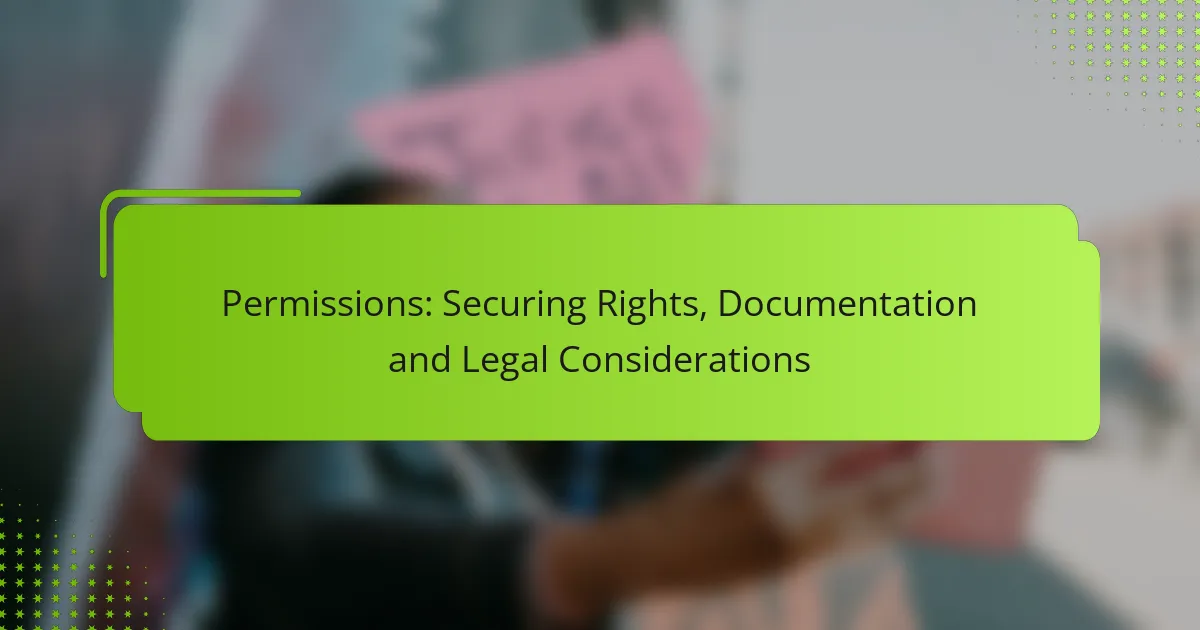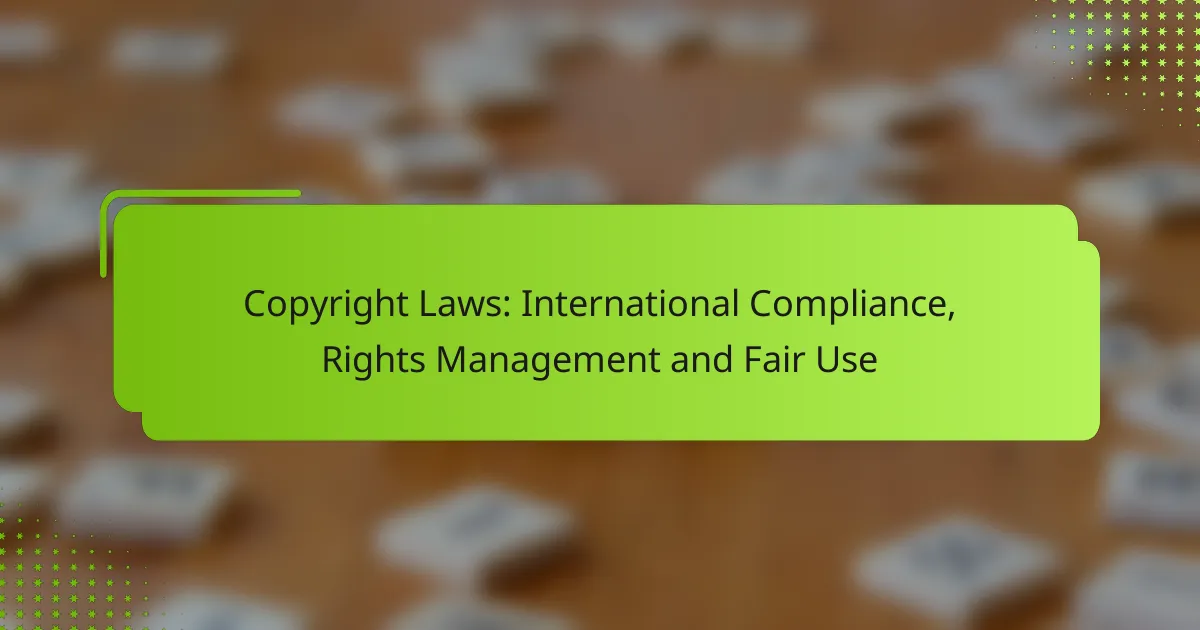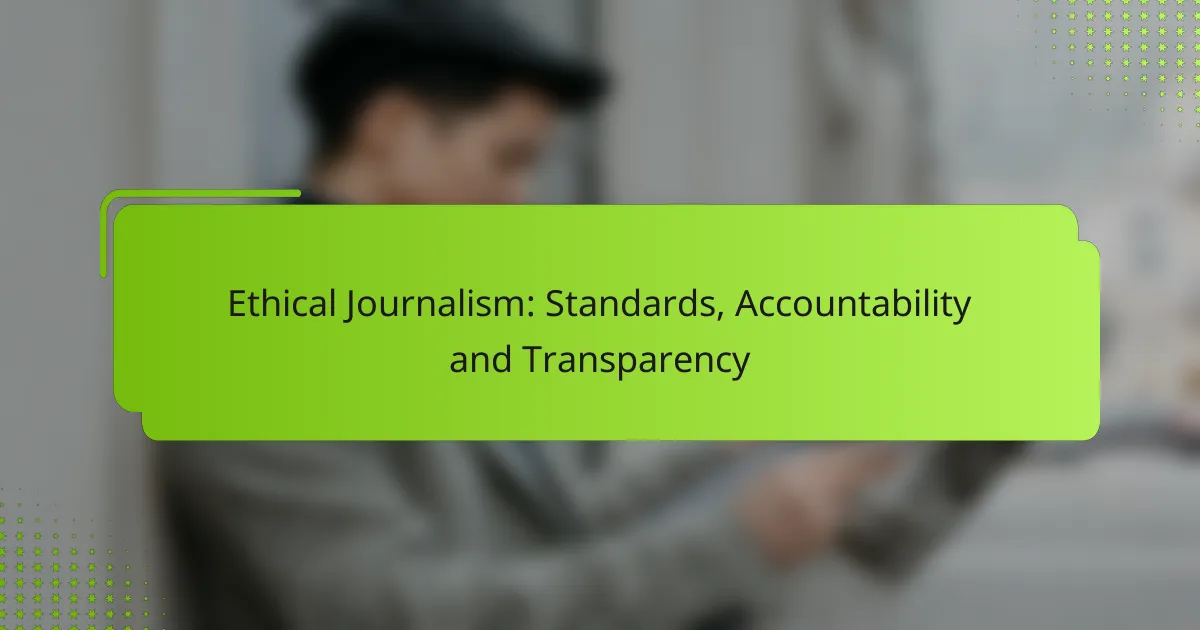Understanding permissions is crucial for creators to safeguard their rights and navigate the complexities of legal documentation. Key elements include copyright permissions, licensing agreements, and fair use considerations, which help ensure that works are used legally and ethically. By securing the necessary rights, individuals can avoid infringement and potential legal disputes, fostering a respectful creative environment.
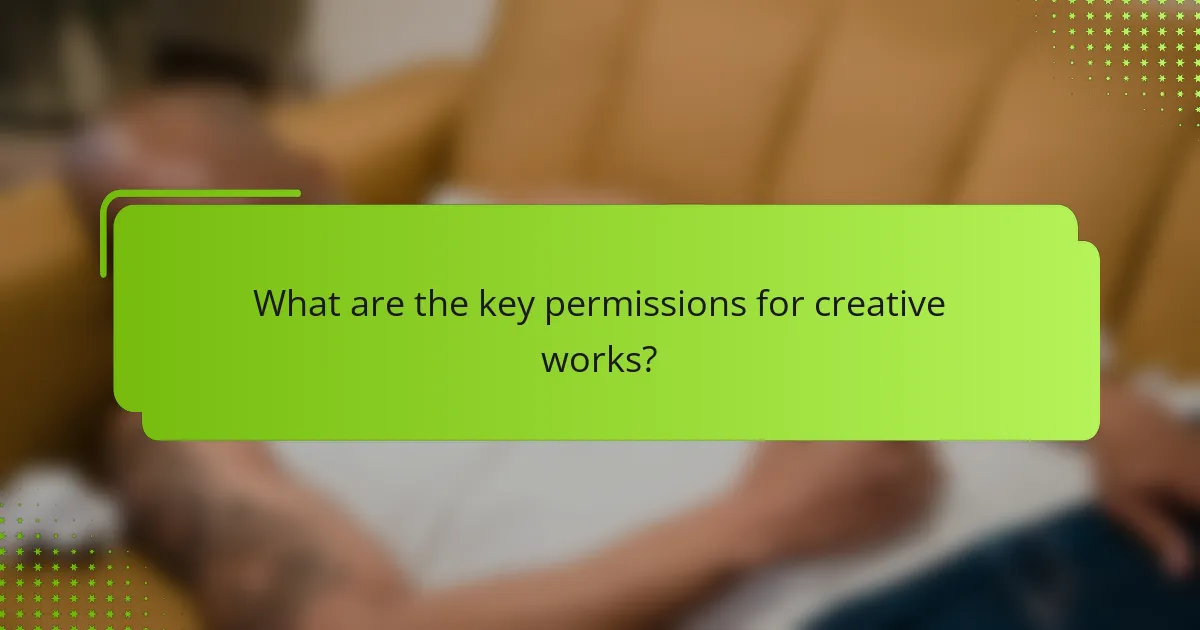
What are the key permissions for creative works?
Key permissions for creative works include copyright permissions, licensing agreements, fair use considerations, public domain status, and Creative Commons licenses. Understanding these elements is essential for creators to protect their rights and navigate the legal landscape of their works.
Copyright permissions
Copyright permissions grant creators exclusive rights to their original works, such as literature, music, and art. These rights typically include reproduction, distribution, and public performance. To use a copyrighted work, one must obtain permission from the copyright holder, which may involve licensing fees or specific terms of use.
Creators should register their works with the relevant copyright office to enhance protection and facilitate enforcement. This can be particularly important in disputes over ownership or unauthorized use.
Licensing agreements
Licensing agreements are contracts that allow one party to use another’s copyrighted work under specified conditions. These agreements can be exclusive or non-exclusive and can cover various rights, such as reproduction, adaptation, or distribution. Clear terms in a licensing agreement help prevent misunderstandings and protect both parties’ interests.
When drafting a licensing agreement, consider including details like duration, territory, and payment terms. This ensures that both the licensor and licensee have a mutual understanding of their rights and obligations.
Fair use considerations
Fair use is a legal doctrine that permits limited use of copyrighted material without permission under certain circumstances. Factors determining fair use include the purpose of use (e.g., educational or commercial), the nature of the copyrighted work, the amount used, and the effect on the market value of the original work.
Creators should be cautious when relying on fair use, as it can be subjective. Seeking legal advice before using copyrighted material under this doctrine is advisable to avoid potential infringement claims.
Public domain status
Works in the public domain are not protected by copyright and can be freely used by anyone. This status can occur when copyrights expire, or the creator explicitly relinquishes their rights. Public domain works can include classic literature, historical documents, and certain government publications.
To identify public domain works, check copyright expiration dates and relevant laws in your country. Utilizing public domain materials can enhance creativity and reduce legal risks in new projects.
Creative Commons licenses
Creative Commons licenses provide a flexible way for creators to share their works while retaining some rights. These licenses allow creators to specify how others can use their work, such as whether modifications are allowed or if the work can be used commercially.
When using Creative Commons-licensed works, it is crucial to adhere to the terms specified in the license, including attribution requirements. This ensures respect for the original creator’s rights while promoting collaboration and sharing within the creative community.

How to secure permissions for media use?
Securing permissions for media use involves obtaining legal rights from the original creators or rights holders. This process ensures that you can legally use their work without infringing on copyright laws.
Contacting rights holders
The first step in securing permissions is identifying and contacting the rights holders of the media you wish to use. This could include artists, photographers, or publishers. Use official websites, social media, or industry directories to find accurate contact information.
When reaching out, be clear about your intentions and the specific media you want to use. This transparency helps build trust and increases the likelihood of a positive response.
Drafting permission requests
Your permission request should be concise and professional. Include details such as your name, organization, the specific media piece, how you intend to use it, and the duration of use. Mention any potential benefits to the rights holder, such as exposure or promotion.
Be polite and respectful in your tone. A well-crafted request can significantly improve your chances of receiving permission.
Negotiating terms
Once you receive a response, you may need to negotiate the terms of use. This can include discussing fees, duration, and the scope of usage. Be prepared to offer compensation, which can vary widely based on the media type and the rights holder’s preferences.
Clarify any restrictions on use, such as geographic limitations or specific formats. Understanding these terms upfront can prevent future disputes.
Documenting agreements
After reaching an agreement, document it in writing. This can be in the form of a formal contract or a simple email confirmation. Ensure that both parties sign or acknowledge the agreement to make it legally binding.
Keep copies of all correspondence and agreements for your records. This documentation can serve as protection in case of any legal issues regarding the use of the media in the future.
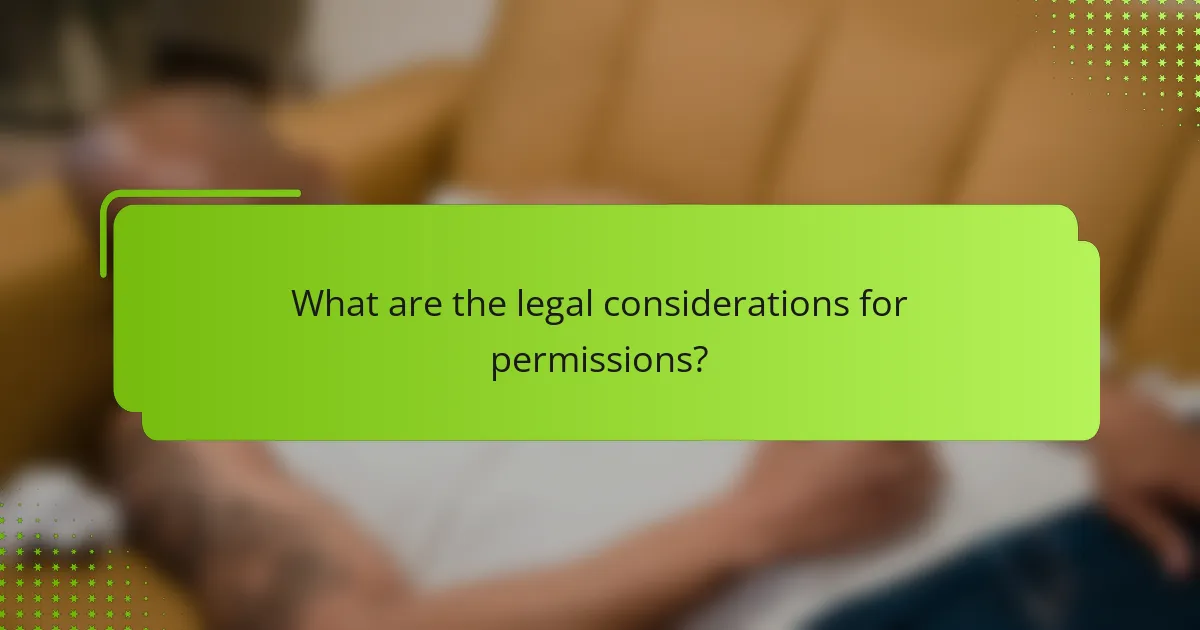
What are the legal considerations for permissions?
Legal considerations for permissions involve understanding copyright laws, the consequences of infringement, and how these laws vary by jurisdiction. Properly securing rights is essential to avoid legal disputes and ensure compliance with applicable regulations.
Understanding copyright law
Copyright law protects original works of authorship, granting creators exclusive rights to use and distribute their creations. This includes literature, music, art, and digital content. To use someone else’s work legally, you typically need to obtain permission or a license, which can vary in scope and duration.
When seeking permission, it’s crucial to clearly define the intended use, such as whether it will be for commercial purposes or educational use. Always document the agreement to avoid misunderstandings later.
Implications of infringement
Infringing on copyright can lead to significant legal consequences, including monetary damages and injunctions against further use. The penalties can range from a few hundred to several thousand dollars, depending on the severity and nature of the infringement.
Additionally, infringement can damage professional reputations and lead to costly legal battles. It’s advisable to conduct due diligence and seek legal advice if unsure about the permissions required for a specific use.
Jurisdictional differences
Copyright laws differ significantly across countries, affecting how permissions are granted and enforced. For instance, the United States follows a “first to create” principle, while many European countries adhere to “moral rights,” which protect the personal and reputational interests of creators.
When working internationally, it’s essential to research the specific copyright laws relevant to each jurisdiction. This ensures compliance and helps avoid potential legal issues when using or distributing creative works across borders.
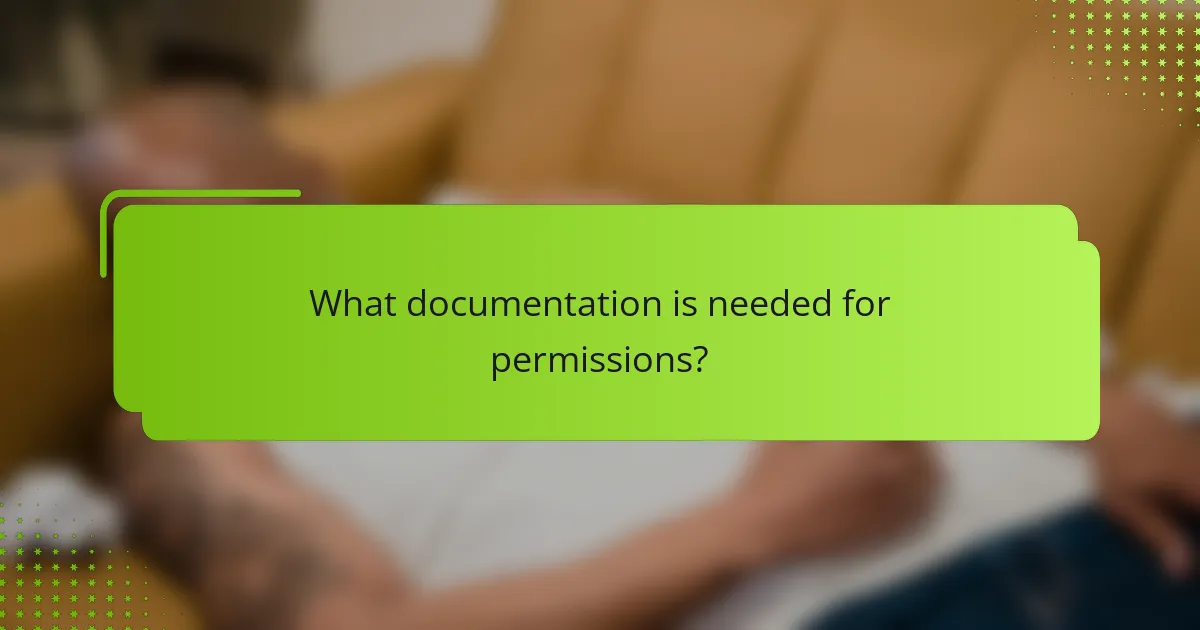
What documentation is needed for permissions?
To secure permissions effectively, it’s essential to gather specific documentation that outlines rights, ownership, and intended usage. Key documents include written agreements, proof of ownership, and usage logs, each serving a distinct purpose in the permissions process.
Written agreements
Written agreements are formal contracts that define the terms under which permissions are granted. These documents should clearly state the rights being transferred, any limitations on usage, and the duration of the agreement. It’s crucial to have these agreements signed by all parties involved to ensure legal enforceability.
When drafting a written agreement, consider including clauses that address potential disputes and specify the governing law. This can prevent misunderstandings and provide a clear path for resolution if issues arise.
Proof of ownership
Proof of ownership is necessary to establish that the individual or entity requesting permission has the legal right to grant it. This can include copyright registrations, purchase receipts, or licenses that demonstrate ownership of the intellectual property in question.
Maintaining organized records of ownership documentation is vital. This not only helps in securing permissions but also protects against potential infringement claims. Ensure that all documents are up-to-date and readily accessible.
Usage logs
Usage logs track how and when a particular work is used, providing evidence of compliance with the terms of the permission granted. These logs can include details such as dates of use, the scope of use, and any modifications made to the original work.
Implementing a systematic approach to maintain usage logs can help in audits or disputes. Regularly review these logs to ensure they accurately reflect usage patterns and adhere to the agreed terms, which can safeguard against potential legal issues.
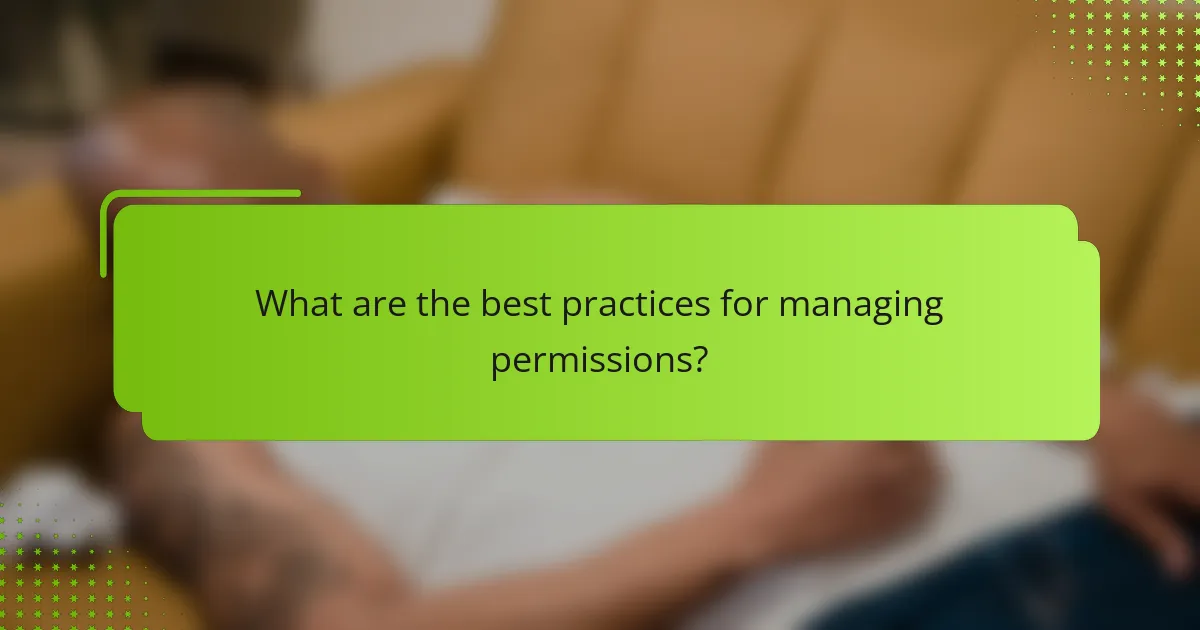
What are the best practices for managing permissions?
Effective management of permissions involves establishing clear protocols, maintaining accurate records, and conducting regular reviews. Best practices ensure that access rights are granted appropriately and that sensitive information remains secure.
Creating a permissions database
A permissions database is essential for tracking who has access to what resources. It should include details such as user identities, roles, access levels, and the date permissions were granted. This centralized repository simplifies management and enhances accountability.
When creating a permissions database, consider using a structured format, such as a spreadsheet or a dedicated software tool. Ensure that it is regularly updated to reflect changes in personnel or access needs. For example, if an employee leaves, their permissions should be revoked immediately to prevent unauthorized access.
Regular audits of permissions
Conducting regular audits of permissions is crucial for maintaining security and compliance. These audits help identify outdated or excessive access rights that could pose risks. Aim to perform audits at least quarterly or biannually, depending on the sensitivity of the data involved.
During an audit, review the permissions assigned to each user and compare them against their current job responsibilities. This process can reveal discrepancies and help enforce the principle of least privilege, ensuring users only have access necessary for their roles. Document findings and take corrective actions promptly to mitigate any identified risks.
